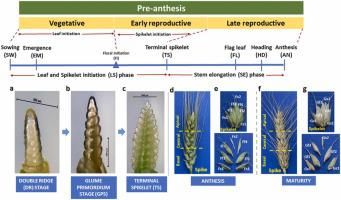Field Crops Research ( IF 5.8 ) Pub Date : 2023-05-08 , DOI: 10.1016/j.fcr.2023.108948 Rajib Roychowdhury, Orian Zilberman, Kottakota Chandrasekhar, Arie Y. Curzon, Kamal Nashef, Shahal Abbo, Gustavo A. Slafer, David J. Bonfil, Roi Ben-David

|
Context
Wheat (Triticum spp.) grain yield (GY) is highly associated with grain number per unit area (GN m-2). Biomass accumulation and partitioning are essential to understand pre-anthesis spike growth dynamics which determines spike dry matter at anthesis (SDMa) - a GN determinant. Spike growth takes place during the stem elongation period (SE), from terminal spikelet to anthesis, following leaf and spikelet initiation (LS) from sowing to terminal spikelet.
Objective
In this study, bread wheat cultivars were examined under Mediterranean semi-arid conditions to determine (i) the varietal differences in pre-anthesis phase duration, (ii) whether this variability influences biomass partitioning and spike-related traits, and (iii) to what extent, the genotypic variations in pre-anthesis phase duration and spike growth are associated with yield components.
Methods
A panel of Israeli commercial bread wheat cultivars were grown in the field during 2016–17 (three environments) and 2017–18 (two environments) and characterized for pre-anthesis phases, floral conditions and spike fertility via histological measurements; spike traits, dry matter accumulation, partitioning at anthesis and maturity and for yield components.
Results
Significant variability in the timing of pre-anthesis phases was detected within the tested panel for both LS and SE phases. LS duration was positively associated with growing degree days (GDD) to anthesis across environments (0.72–0.90) while variation in SE was related with differences in GDD to anthesis but to a lesser extent and not in all environments (0.47–0.79). In addition, LS duration, and occasionally SE, were favourably related with a higher dry matter of fertile florets spike-1 (at anthesis) and SDM (at both anthesis and maturity). Principal component analysis (PCA) clearly separates environments and to a lesser extent cultivars within each environment. Two cultivar pairs 'Zahir-Yuval' and 'Negev-Gedera', which flowered concurrently, showed significant differences in the durations of LS and SE phases across most of the environments. Longer LS, in cultivars Zahir and Negev, exhibited increased spikelets spike-1, whereas longer SE (e.g., in Yuval and Gedera) enhanced spike fertility through improving the survival rate of floret primordia (FSR%) of central spikelets. However, there was a trade-off for FSR at the proximal and distal spike portions, resulting in lower grain set (%) leading to reduction of final GN (or GY) in cultivars with longer SE.
Conclusions
In the tested panel and under our environmental conditions characterized by growing cycle and Mediterranean climate, the duration of both LS and SE contribute to spike fertility, but LS duration seemed a stronger driver than SE for GN and yield enhancement.
Implications
Our results highlight the importance of pre-anthesis phases, especially the role of LS in wheat yield increment during the short growing cycle. The varietal combination with variable LS and SE duration could be implemented in breeding pipelines and used as pre-breeding materials for GN improvement. Furthermore, the findings will encourage pre-anthesis traits adoption in Mediterranean bread wheat future breeding programs.
中文翻译:

地中海气候下优质面包小麦品种(Triticum aestivum L. spp.)花前穗生长动态及其与产量构成的关系
语境
小麦 ( Triticum spp.) 籽粒产量 (GY) 与单位面积籽粒数 (GN m -2 )高度相关。生物量积累和分配对于了解花前穗生长动态至关重要,后者决定开花时穗干物质 (SDMa) - GN 的决定因素。穗状花序生长发生在茎伸长期 (SE),从末端小穗到开花,随后是从播种到末端小穗的叶和小穗起始 (LS)。
客观的
在这项研究中,在地中海半干旱条件下对面包小麦品种进行了检查,以确定 (i) 开花前期持续时间的品种差异,(ii) 这种变异性是否影响生物量分配和穗状花序相关性状,以及 (iii) 到花前阶段持续时间和穗生长的基因型变异在多大程度上与产量构成相关。
方法
一组以色列商业面包小麦品种在 2016-17 年(三种环境)和 2017-18 年(两种环境)期间在田间种植,并通过组织学测量对开花前阶段、开花条件和穗肥力进行了表征;穗状花序、干物质积累、开花期和成熟期的分配以及产量构成因素。
结果
在 LS 和 SE 阶段的测试面板中检测到开花前阶段时间的显着变化。LS 持续时间与跨环境(0.72-0.90)到开花的生长度天数(GDD)呈正相关,而 SE 的变化与 GDD 到开花的差异相关,但程度较小,并非在所有环境中(0.47-0.79)。此外,LS 持续时间和偶尔的 SE 与可育小花穗状花序的较高干物质有利相关-1(开花期)和 SDM(开花期和成熟期)。主成分分析 (PCA) 明确区分环境,并在较小程度上区分每个环境中的品种。同时开花的两个品种对 'Zahir-Yuval' 和 'Negev-Gedera' 在大多数环境中显示出 LS 和 SE 阶段持续时间的显着差异。在栽培品种 Zahir 和 Negev 中,较长的 LS 表现出增加的小穗穗-1 ,而较长的 SE(例如,在 Yuval 和 Gedera 中)通过提高中央小穗的小花原基 (FSR%) 的存活率来增强穗生育力。然而,近端和远端穗部的 FSR 存在折衷,导致较低的结粒率 (%) 导致具有较长 SE 的品种的最终 GN(或 GY)减少。
结论
在测试面板中以及在我们以生长周期和地中海气候为特征的环境条件下,LS 和 SE 的持续时间都有助于提高生育率,但 LS 持续时间似乎比 SE 对 GN 和产量提高的驱动力更强。
启示
我们的结果强调了开花前阶段的重要性,尤其是 LS 在短生长周期内对小麦增产的作用。具有可变 LS 和 SE 持续时间的品种组合可以在育种管道中实施,并用作 GN 改良的预育种材料。此外,这些发现将鼓励地中海面包小麦未来育种计划采用开花前性状。


























 京公网安备 11010802027423号
京公网安备 11010802027423号